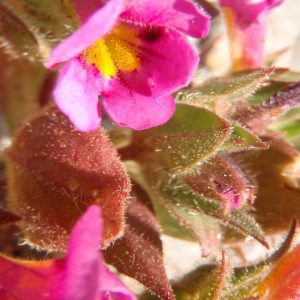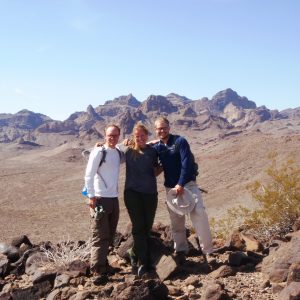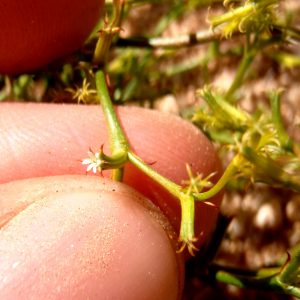This August and September have been spectacular in the Mojave Desert. We’ve more monsoonal rains than is typical for the area, which resulted in flowers sprouting up all over the desert. June and July were very hot and dry here (it was at least 115° here every day for a couple of months!) and much of the vegetation had dried up, so it was kind of disorienting when I started noticing the post-monsoon bloom taking place. Some species flowered again that typically flower in the spring, but other plants in this area are specifically adapted to respond to summer rain. I’ve found some pretty strange looking plants this summer! Some cover hundreds of thousands of miles of the desert, such as chinch-weed (Pectis papposa var. papposa). This low-growing, yellow annual has turned large parts of the Mojave yellow. Driving along, I’d suddenly notice that where there used to be dry ground, there is now an extensive yellow blanket of flowers. It is pretty spectacular. Amaranthus fimbriatus is another very showy post-monsoonal bloomer.
Unfortunately, all the rain we’ve had has also triggered growth in a population of Arundo donax (giant cane) at several of the more productive springs we manage. It had been cut and burned several years ago, and that method of control had been sufficient up until this summer. I’ll be cutting down the Arundo and covering the rhizomes with heavy black tarps in order to prevent its regrowth. In addition, I’ve been monitoring springs and seeps, working with GIS data, and I may make another seed collection or two this fall.
Here are some photos of my encounters with cacti over the course of this internship. Yes, some of these cacti are Sonoran Desert species, and the photos of the organ pipe and saguaro cacti and the chainfruit cholla are from Organ Pipe National Monument in Arizona, but there is also a fairly large population of Carnegia gigantea (saguaro cacti) in the Needles Field Office. Pretty cool.
The biggest news I have is that I will be converting to a SCEP position at the end of my internship. I managed to get into the SCEP (Student Career Experience Program) right before it changed to the Pathways Program. I’m taking classes this semester through Northern Arizona University, and will be taking classes full-time in the spring toward a Master of Science in Forestry degree. A SCEP entails beginning work with a federal agency while you take classes towards a degree. The agency you’re working for pays for your tuition, and when you are finished with your degree, they can hire you non-competitively. Then there is a minimum time you agree to stay with said agency to make it worth their funding of your education. I’m really excited about the opportunity to start my graduate career, and I’m looking forward to finally having a full-time job. So I’ll be working in the Needles, CA Field Office for at least the next 4 years! I’ll be responsible for monitoring grazing allotments, area burro populations, invasive plant species, natural water sources, unusual plant assemblages, abandoned mines, and overseeing habitat restoration efforts and mitigation, as well as assessing project compliance with Section 7 of the Endangered Species Act for the Mojave desert tortoise (Gopherus agassizii). No small order, as I’ll essentially be the only member of our Natural Resources Branch for the foreseeable future! Good luck to everyone else with their internships, and if you ever need a couch to surf on, you’ll know where to find me!
Lara Kobelt
Botany/Seeds of Success Intern
Needles, California






























